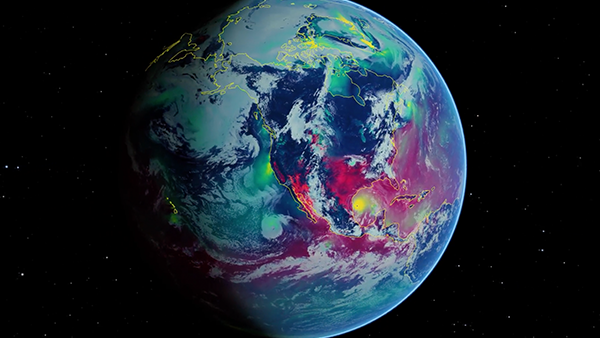Blog
Forecasting the Weather Beyond Two Weeks Using NVIDIA Earth-2

Understanding Long-Term Weather Forecasting with NVIDIA Earth-2
Weather forecasting has evolved significantly over the years, and technology plays a crucial role in improving accuracy and extending predictive capabilities. One of the most advanced technologies in this field is NVIDIA Earth-2. This groundbreaking initiative leverages deep learning and advanced simulations to enhance weather forecasting beyond the traditional two-week horizon. In this blog post, we’ll explore how NVIDIA Earth-2 works, the benefits it offers, and its implications for various sectors.
What is NVIDIA Earth-2?
NVIDIA Earth-2 is a cutting-edge simulation platform created to model Earth’s climate and weather patterns with unprecedented detail. Utilizing powerful AI and graphics processing unit (GPU) technology, it can simulate complex phenomena by processing vast amounts of data in real-time. This allows researchers and meteorologists to predict weather patterns and climate changes with improved reliability and precision.
The Technology Behind NVIDIA Earth-2
AI and Machine Learning
At the core of NVIDIA Earth-2 is artificial intelligence. Machine learning algorithms analyze historical weather data and identify patterns that might not be apparent through traditional methods. By training these models on vast datasets, NVIDIA can create simulations that accurately reflect potential future weather scenarios.
Real-Time Data Processing
One of the distinguishing features of Earth-2 is its ability to process real-time data. By continuously analyzing incoming weather information, it can update its forecasts and simulations, offering the most current insights available. This capability is particularly useful in rapidly changing weather conditions, such as during severe storms or heatwaves.
Extending the Forecasting Horizon
While traditional weather forecasts are typically reliable for up to two weeks, NVIDIA Earth-2 improves this timeframe significantly.
Unraveling Long-Term Patterns
By examining both short-term and long-term climate data, the platform allows scientists to identify patterns that impact weather over extended periods. For example, it can help predict seasonal changes, such as droughts or unusually wet conditions, which are harder to forecast with conventional methods.
Comprehensive Climate Models
NVIDIA Earth-2 employs complex climate models that consider various environmental factors, such as ocean temperatures, atmospheric pressure systems, and land use. This holistic approach leads to understanding how each element interacts within the larger ecosystem, providing a more comprehensive view of future weather patterns.
Benefits of Extended Weather Forecasting
Agriculture
Farmers and agricultural sectors stand to gain significantly from extended weather predictions. With access to reliable long-term forecasts, farmers can plan their planting and harvesting schedules more effectively. They can determine the best times for irrigation and manage resources efficiently, optimizing yield while minimizing waste.
Disaster Preparedness
Accurate long-term forecasts can also enhance disaster preparedness. Governments and emergency services can utilize this information to strengthen infrastructure, allocate resources more efficiently, and develop better evacuation plans. For regions that are prone to extreme weather, timely forecasts can mean the difference between life and death.
Energy Sector Optimization
The energy sector relies heavily on weather data for operational planning. Accurate forecasts help power companies manage resources wisely, ensuring they can meet consumer demand efficiently. For instance, anticipating a heatwave can lead to preemptive measures in energy production to avoid shortages and blackouts.
Challenges in Long-Term Forecasting
While NVIDIA Earth-2 offers remarkable advancements, there are challenges inherent to long-term weather forecasting that remain.
Data Limitations
Although immense amounts of data are processed, the quality and quantity of the data can significantly influence forecasting effectiveness. In some areas, the lack of comprehensive data can lead to inaccuracies. Ensuring a constant flow of high-quality data is crucial for reliable forecasts.
Climate Variability
Climate is inherently variable, and unforeseen factors can impact weather patterns unpredictably. While NVIDIA Earth-2 can simulate many scenarios, it cannot account for every potential anomaly. Ongoing research and adjustments to the models are essential to continually refine the accuracy of predictions.
The Future of Weather Forecasting with NVIDIA Earth-2
A Collaborative Effort
The future of weather forecasting lies in collaboration between technology developers, meteorologists, and government agencies. By sharing data and intertwining resources, stakeholders can create an integrated approach that bolsters forecasting accuracy.
Sustainable Practices
As the impacts of climate change become more pronounced, sustainable practices in agriculture, energy production, and urban planning will become increasingly essential. Extended forecasts from platforms like NVIDIA Earth-2 can guide industries in developing practices that minimize carbon footprints while optimizing operations.
Continuous Learning
The algorithms used by NVIDIA Earth-2 are designed to learn and adapt over time. As more data becomes available and new methodologies are developed, the platform will improve its predictions. This evolution underscores the dynamic nature of science and technology in addressing complex challenges.
Conclusion
NVIDIA Earth-2 represents a significant leap forward in long-term weather forecasting. By melding sophisticated AI technology with advanced climate modeling, it provides valuable insights that can have far-reaching benefits across various sectors. As improvements continue in both data quality and modeling skills, we can expect even more accurate forecasts that help mitigate the impacts of changing climates. The future of weather forecasting is not just about understanding the immediate weather; it’s about anticipating the long-term impacts that affect all of us.
